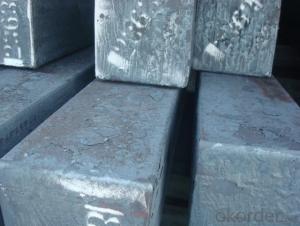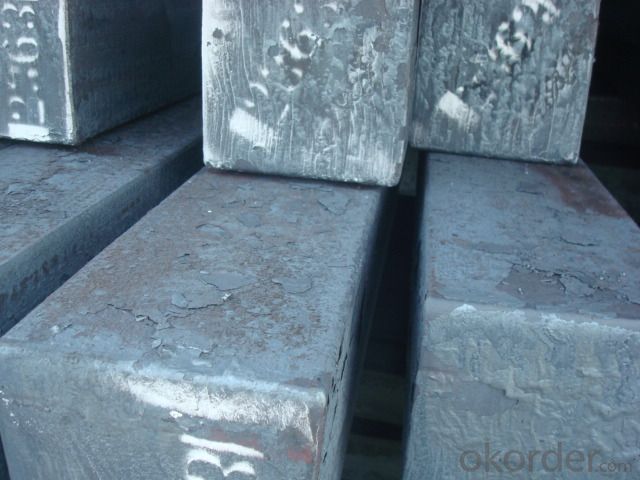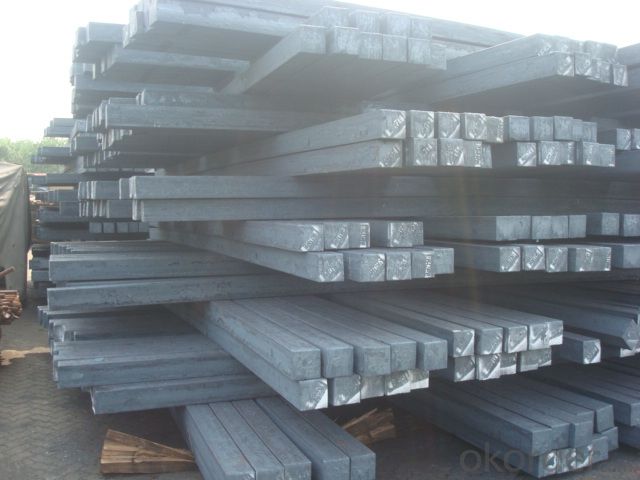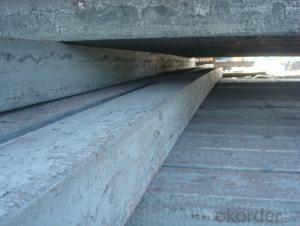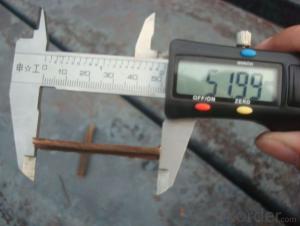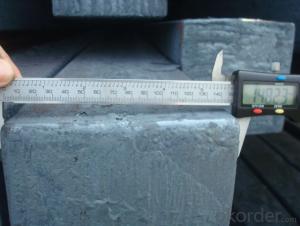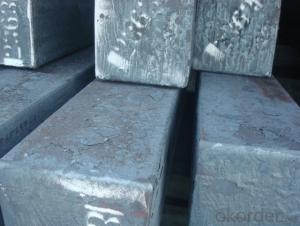Steel Billet Manufactured by Blast Furnace with Good Quality
- Loading Port:
- Tianjin
- Payment Terms:
- TT OR LC
- Min Order Qty:
- 1000 m.t.
- Supply Capability:
- 100000 m.t./month
OKorder Service Pledge
OKorder Financial Service
You Might Also Like
Steel Billet Manufactured by Blast Furnace with Good Quality
1.Structure of Steel Billet Manufactured by Blast Furnace with Good Quality
Steel Billet Manufactured by Blast Furnace without Boron is the raw material of all kinds of steel mill. Billet section of square, round, flat, rectangular and abnormity, etc Several, mainly related to shape of rolled products. Simple rolled section steel, choose cross section of square billet or rectangular billet. rolling The sector products such as flat steel, Angle steel, select the rectangular billet or slab. Had better profiled billet when production beams, channels, and in rolling process Lines and improve the yield. The raw material of round billet is the production of seamless tube.
2.Main Features of Steel Billet Manufactured by Blast Furnace with Good Quality
Steel Billet Manufactured by Blast Furnace without Boron section size should meet the requirements of rolling deformation and finished product quality, but also roll strength and biting condition of restrictions. General steel Billet section height H. And the roll diameter D The ratio of the ( namely H/D) Should be less than or equal to zero 0.5 . Length of steel billet by finishing temperature, Rolling time and the length of the product Or times ruler. When heated too long accident prone to bump the furnace wall of steel, too short, furnace bottom utilization rate is not high, influence the heating furnace production. For the production Choose a variety of steel and steel billet, should consider the affinities of billet, as far as possible in order to improve the productivity of the roughing mill, simplify the stock management of workshop.
3. Steel Billet Manufactured by Blast Furnace with Good Quality Images
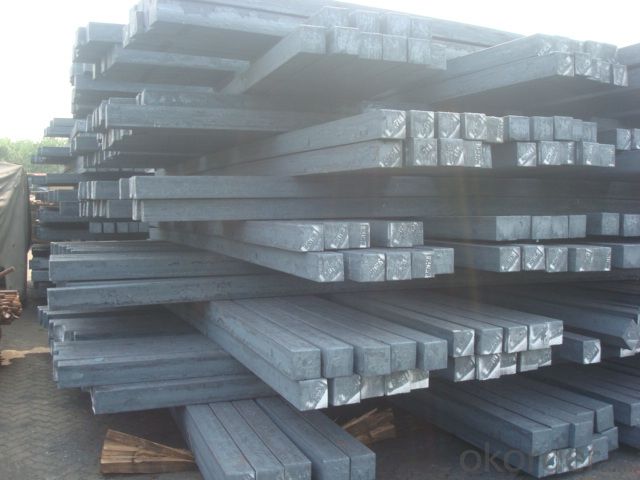
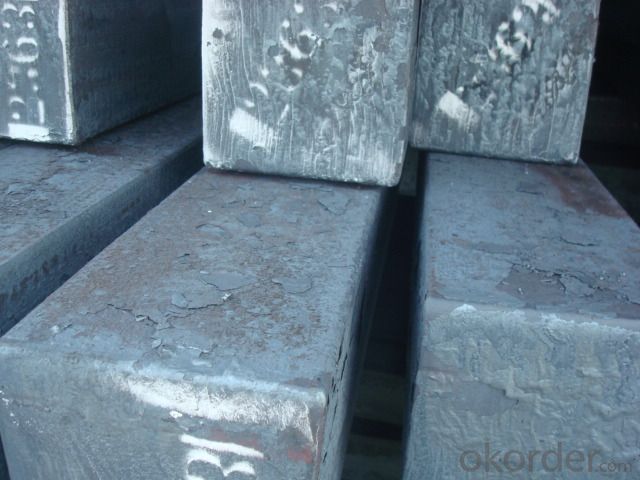
4. Steel Billet Manufactured by Blast Furnace with Good Quality Specification
Steel Billet Manufactured by Blast Furnace without Boron rolled steel, after processing can be used for mechanical parts, forging parts, processing all kinds of steel, steel Q345B channel steel, wire rod is the role of the billet. Steel billet is used in the production of semi-finished products, generally cannot be used directly for the society. Steel billets and steel are strictly divided into standard, cannot decide to whether the business enterprise of the final product, and according to unified standards to perform the whole society. Typically, billet and the steel is relatively easy to distinguish, but for some steel billet, and have the same specification and same steel purposes (such as rolling tube billet), whether can be used for other industries, whether through steel processing process, whether through a finished product rolling mill processing to distinguish
The classification of the Bloom Mainly from the shape is divided into two kinds: Slab: cross section width and height of the ratio of the larger, mainly used for rolling plate. Bloom: equal cross section width and height, or a huge difference, mainly used for rolling steel, wire rod.
Bloom material standard The thickness range: 150-240 - mm + / - 5 mm The width of the range: 880-1530 - mm + / - 20 mm Length range: 3700-10000 - mm + / - 500 - mm Cross-sectional size: 64 * 64 ; 82 * 82 ; 98 * 98 ; 124 * 124 ; 120 * 150 ; 152 * 164 ; 152 * 170 mm Length: 9000 mm The section of tolerance: Bloom: 1.0 + / - 2.0-1.0 + / - 1.0 mm The slab width: + / - 2.0 MM ; Thickness: + / - 3.0 MM
5.FAQ of Steel Billet Manufactured by Blast Furnace with Good Quality
We have organized several common questions for our clients,may help you sincerely:
①What kinds of the spec. you can supply?
Q195/Q215/Q235/Q255/Q275 or other chemical composition you require.
②What is the standard of the steel billet?
Chinese standard is GB700.
③How is the packaging and delivery?
Exporting Package with the steel material cover and the delivery term is based on the project.
- Q: How are steel billets inspected for surface defects?
- To ensure the quality and integrity of steel billets, a variety of methods and techniques are employed to inspect them for surface defects. One way is through visual inspection, where trained inspectors carefully scrutinize the billets for any visible flaws such as cracks, scratches, pits, or unevenness. They utilize appropriate lighting and magnification tools to conduct a thorough examination of the entire surface. Another method in use is dye penetrant testing. This involves applying a liquid dye to the billet's surface, allowing it to seep into any cracks or defects. After a designated period, excess dye is removed and a developer is added. The developer brings out the dye from any defects, making them clearly visible and easily identifiable. Magnetic particle inspection is another widely utilized technique. During this process, the billets are magnetized, and iron particles are applied to the surface. Any surface flaws disrupt the magnetic field, causing the iron particles to gather around the defect, thus making them easily detectable upon inspection. This method proves particularly effective for identifying defects such as surface cracks. Ultrasonic testing is also commonly employed to inspect steel billets. It entails transmitting high-frequency sound waves through the material, which then produce reflections or echoes when encountering any surface defects or internal flaws. These reflections are detected and analyzed, providing valuable information about the defect's size, location, and type. Furthermore, eddy current testing can be utilized to inspect steel billets for surface defects. This method involves passing an alternating current through a probe positioned near the billet's surface. Any defects or variations in the material's conductivity cause changes in the eddy currents, which can be detected and analyzed to identify surface defects. In conclusion, steel billets undergo meticulous inspection utilizing a combination of visual, dye penetrant, magnetic particle, ultrasonic, and eddy current testing methods. This ensures that any surface defects are promptly identified and addressed, thereby guaranteeing the quality and reliability of the final product.
- Q: How are steel billets classified based on their chemical composition?
- Steel billets can be classified based on their chemical composition using different grading systems. One common classification method is based on the carbon content of the billets. This method categorizes steel billets into three main groups: low carbon steel billets, medium carbon steel billets, and high carbon steel billets. Low carbon steel billets typically have a carbon content of less than 0.25%. These billets are known for their excellent ductility and weldability. They are commonly used in applications that require good formability and low strength, such as construction materials and automotive components. Medium carbon steel billets usually have a carbon content ranging from 0.25% to 0.60%. These billets have improved strength and hardness compared to low carbon steel billets. They are commonly used in applications that require higher strength, such as machinery parts, shafts, and gears. High carbon steel billets have a carbon content greater than 0.60%. These billets are known for their exceptional strength and hardness. They are commonly used in applications that require high wear resistance, such as cutting tools, springs, and knives. Apart from the carbon content, other chemical elements present in the steel billets can also affect their classification. For example, the presence of alloying elements like chromium, nickel, and molybdenum can enhance the properties of the steel, such as corrosion resistance or heat resistance. Steel billets can be further classified based on the specific alloying elements present and their concentrations. Overall, the classification of steel billets based on their chemical composition allows for better understanding and selection of the appropriate material for specific applications, ensuring the desired properties and performance of the final product.
- Q: How are steel billets used in the production of electrical transmission towers?
- Steel billets are an essential component in the production of electrical transmission towers. These billets are essentially semi-finished steel products that are cast into a specific shape and size. In the case of electrical transmission towers, steel billets are used as raw material to manufacture the tower structures. The process begins with the selection of high-quality steel billets, which are carefully inspected for their chemical composition and physical properties. Once the billets meet the required specifications, they are heated and passed through a series of rolling mills to form the desired shape and size of the tower sections. The steel billets are first heated to a specific temperature to make them malleable. This heating process helps in reducing the internal stresses and enhancing the ductility of the steel. The heated billets are then passed through multiple rolling stands, where they are shaped into various sections such as angles, channels, and I-beams. These sections are further cut into appropriate lengths and welded together to form the framework of the transmission tower. The steel billets provide the necessary strength and structural integrity to withstand the weight of the tower, as well as the environmental loads such as wind and ice. Moreover, the use of steel billets ensures that the transmission towers have excellent corrosion resistance, as steel is known for its durability and longevity. This is crucial in maintaining the reliability and safety of the power transmission infrastructure. Overall, steel billets play a vital role in the production of electrical transmission towers by providing the raw material required for manufacturing the tower structures. Their strength, durability, and corrosion resistance make them an ideal choice for constructing towers that can support the transmission lines and ensure the efficient and reliable distribution of electricity.
- Q: What are the different surface treatments for improved surface cleanliness in steel billets?
- There are several surface treatments available for improving surface cleanliness in steel billets. These treatments are designed to remove impurities, oxides, and contaminants from the surface of the billets, resulting in a cleaner and more uniform surface. One common surface treatment is pickling, which involves immersing the steel billets in an acid solution. The acid helps dissolve and remove any oxides or scale present on the surface of the billets. This process not only cleans the surface but also helps improve the adhesion of subsequent coatings or treatments. Another surface treatment option is shot blasting or abrasive blasting. This process involves propelling abrasive materials, such as steel shot or grit, at high speeds onto the surface of the billets. The impact of the abrasive particles removes any contaminants, rust, or scale, resulting in a cleaner surface. Shot blasting is an effective method for preparing the surface of steel billets for further processing or coating. Chemical cleaning is another surface treatment technique used to improve cleanliness in steel billets. This process involves using chemical agents to dissolve and remove contaminants from the surface. Different chemicals, such as alkaline or acid-based solutions, can be employed depending on the type and severity of the contaminants present. Chemical cleaning can be an effective method for removing stubborn contaminants or residues from the surface of the billets. Additionally, mechanical cleaning methods, such as wire brushing or grinding, can be used to improve surface cleanliness. These techniques involve physically removing contaminants or scale from the surface using mechanical means. Wire brushing uses wire bristles to scrub the surface, while grinding involves the use of abrasive materials to remove any imperfections or contaminants. Overall, the choice of surface treatment for improved cleanliness in steel billets depends on several factors, including the specific contaminants present, the desired level of cleanliness, and the intended application of the billets. It is essential to consider the effectiveness, cost, and environmental impact of each treatment method to select the most suitable option.
- Q: How are steel billets used in the manufacturing of machinery?
- Steel billets are an essential component in the manufacturing of machinery due to their versatility and strength. These cylindrical metal bars, typically made from carbon or alloy steel, serve as the raw material that is transformed into various machine parts and components. One common application of steel billets in machinery manufacturing is for the production of machine frames and structures. The billets are heated and then hot-rolled or forged into the desired shape, ensuring the final product has the necessary strength and durability to withstand the mechanical stresses it will encounter during operation. Additionally, steel billets are used to create machine components such as gears, shafts, and axles. These parts require high tensile strength and resistance to wear and deformation, making steel billets the ideal material choice. The billets are typically machined or forged into the desired shape, ensuring precise dimensions and tolerances are met. Furthermore, steel billets can also be used in the manufacturing of machine tools, which are crucial for shaping and machining various materials. By using steel billets as the base material, machine tools can effectively handle heavy loads, provide stability, and ensure precision in the manufacturing processes. In summary, steel billets are integral to the manufacturing of machinery, as they provide the necessary strength, durability, and versatility required for the production of machine frames, components, and tools. Their ability to be shaped, machined, and forged into various forms allows for the creation of high-quality machinery that can effectively perform its intended functions.
- Q: How do steel billets contribute to the manufacturing of household appliances?
- Steel billets play a crucial role in the manufacturing of household appliances. These billets serve as the raw material for the production of various components and structures used in household appliances. Firstly, steel billets are used to manufacture the frames and structures of appliances such as refrigerators, washing machines, and dishwashers. The high strength and durability of steel make it an ideal choice for these applications, ensuring that the appliances can withstand the constant use and heavy loads they encounter. Secondly, steel billets are used to produce the inner and outer panels of household appliances. These panels require a material that is strong, resistant to corrosion, and aesthetically pleasing. Steel fits these criteria perfectly, providing a sleek and durable surface that can be easily cleaned and maintained. Additionally, steel billets are used to create various components within household appliances, including heating elements, motors, and electrical parts. Steel's excellent thermal conductivity and electrical properties make it a suitable material for these critical components, ensuring efficient operation and reliable performance. Furthermore, steel billets contribute to the overall safety of household appliances. Steel is a fire-resistant material, reducing the risk of accidents caused by overheating or electrical malfunctions. Its strength and stability also play a role in preventing structural failures that could lead to accidents or injuries. In summary, steel billets are essential in the manufacturing of household appliances due to their strength, durability, corrosion resistance, and thermal/electrical properties. By providing the necessary raw material, steel billets enable the production of robust structures, aesthetic panels, critical components, and safe appliances that meet the demands and expectations of consumers.
- Q: Our caster is square billet! 150X500! That is, every time we open the head, there is slag inclusion. And pores! Yes, the first 3 meters! There's no more left behind! How did it happen, please?! We have a refinery and electromagnetic stirring! Give me a hand!
- In the production process of steel castings, the appearance of quality defects is unavoidable. It is essential to take reasonable measures to avoid the inclusion of slag in the cast steel. It is necessary to understand the reason why the porosity of the cast steel is caused by slag inclusion so that the quality of the cast steel can be improved.In order to solve the pinhole of slag phenomenon, the first thing to do is to understand the cause of steel casting porosity slag phenomenon, and take corresponding measures according to the original material,
- Q: What is the role of steel billets in the manufacturing of tools and dies?
- Steel billets are essential for the production of tools and dies, playing a crucial role in the manufacturing process. These semi-finished steel products serve as the starting material, being heated, forged, and shaped to create the desired tools and dies used in different industries. The use of steel billets offers several advantages, primarily due to their high strength and durability. Steel is known for its excellent mechanical properties, such as hardness, toughness, and wear resistance. When manufacturers use high-quality steel billets, they can be confident that the resulting tools and dies will have the necessary strength and durability to withstand demanding conditions. In addition, steel billets provide versatility in terms of customization. They can be easily shaped and formed into various sizes and dimensions, allowing manufacturers to create tools and dies that meet specific requirements. Whether it's a complex mold or a precision cutting tool, steel billets offer the flexibility needed to produce intricate and accurate components. Moreover, steel billets are preferred in the manufacturing of tools and dies due to their thermal conductivity. Steel effectively conducts heat, which is crucial for processes like heat treatment, quenching, and tempering. These thermal treatments are often used to enhance the hardness and strength of tools and dies, making them more resistant to wear and extending their lifespan. In conclusion, steel billets are indispensable in the manufacturing of tools and dies. They serve as the primary material for these components, providing high strength, durability, customization options, and thermal conductivity. By utilizing steel billets, manufacturers can create tools and dies that meet the demanding requirements of various industries, ensuring optimal performance and longevity.
- Q: How are steel billets used in the production of pipes?
- Steel billets are an essential raw material in the production of pipes. They are used as a starting point for the manufacturing process, where they undergo various transformations to eventually become pipes. Firstly, steel billets are heated to a high temperature to make them malleable. This process, known as hot rolling, allows the billets to be shaped into long cylindrical forms. The heating also improves the steel's internal structure and removes any impurities. Once the billets are heated, they are sent through a series of rolling mills. These mills gradually reduce the billet's size and shape it into a round bar called a "bloom." The bloom is then further processed by passing it through a piercing mill, which creates a hollow cavity in the center. After the piercing process, the bloom is then elongated and shaped into a pipe while being continuously rolled. The elongation process is achieved by passing the bloom through a series of sizing mills, where it is gradually stretched and shaped into the desired pipe dimensions. This continuous rolling process ensures a uniform thickness and shape throughout the length of the pipe. Additionally, steel billets can also be used to produce seamless pipes. In this case, the billets are heated and pierced in a similar manner as described above. However, instead of being elongated through rolling, the pierced billet is further processed by being elongated and reduced in diameter using a process known as extrusion. This results in a seamless pipe with no welded joints, which is often preferred in industries such as oil and gas. Overall, steel billets play a crucial role in the production of pipes. They are transformed through heating, rolling, and shaping processes to create pipes of various sizes and types. These pipes are then used in various industries, such as construction, infrastructure, and energy, for transporting fluids and gases.
- Q: What are the different types of machining processes used for shaping steel billets?
- Shaping steel billets can be achieved through various machining processes. Below are some of the most commonly employed methods: 1. Turning: By rotating the billet against a cutting tool, material is removed from the outer surface. This technique is frequently utilized to produce cylindrical shapes or eliminate excess material from the billet. 2. Milling: Material is removed from the billet's surface using a rotating cutting tool. This process is suitable for creating flat surfaces, slots, or intricate shapes. 3. Drilling: Holes are created in the billet by employing a rotating cutting tool. This can be accomplished manually or with the aid of a drilling machine. 4. Grinding: An abrasive wheel or belt is employed in grinding to eliminate material from the billet's surface. It is commonly used to achieve a smooth and precise finish. 5. Broaching: Broaching involves the use of a toothed cutting tool called a broach to remove material from the billet. This method is often employed to create internal or external splines, keyways, or other specialized shapes. 6. Sawing: Sawing is a cutting technique that utilizes a saw blade to divide the billet into smaller sections or remove excess material. This can be done manually or with the assistance of a sawing machine. These examples illustrate just a few of the machining processes utilized in shaping steel billets. Each process offers unique advantages and is selected based on the specific requirements of the final product.
Send your message to us
Steel Billet Manufactured by Blast Furnace with Good Quality
- Loading Port:
- Tianjin
- Payment Terms:
- TT OR LC
- Min Order Qty:
- 1000 m.t.
- Supply Capability:
- 100000 m.t./month
OKorder Service Pledge
OKorder Financial Service
Similar products
Hot products
Hot Searches
Related keywords
